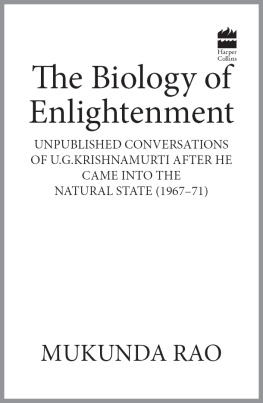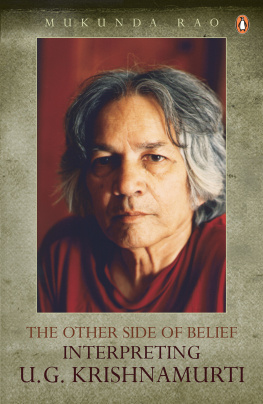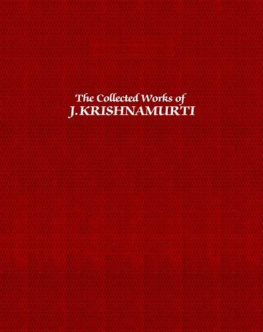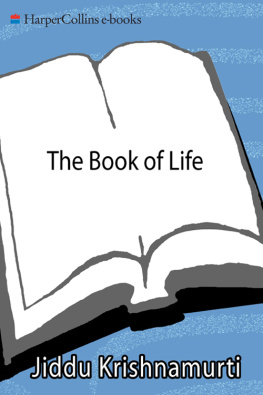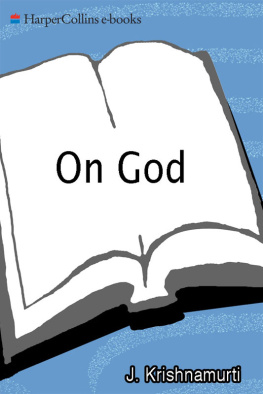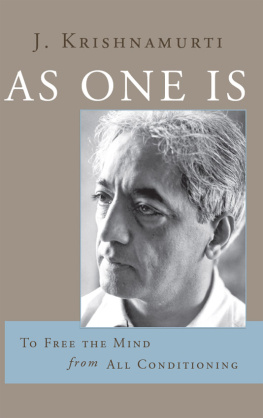
The Biology of Enlightenment
UNPUBLISHED CONVERSATIONS OF
U.G.KRISHNAMURTI AFTER HE CAME INTO THE
NATURAL STATE (196771)
Edited and with an Introduction by
M UKUNDA R AO

This has to be on a person-to-person level; you cant do it in a large group. And this is not an interpretation of anybodys teaching; it does not throw new light on anybodys teaching or any spiritual text. I am not putting forth an intellectually constructed set of ideas. It is born out of my own spiritual experience if I may use the term, for want of a better or more adequate one that has put an end to the experiencing structure once and for all.

Actually, what I am saying here is something you bring out. That what is said here is your property, not mine. The limitations, the frontiers are all gone. It is all one. Whatever is happening here is happening for the whole of human consciousness. You dont have to do a thing. You dont have to start a foundation or a society. It is not for you to preserve the teaching for posterity.

I have no teaching. There is nothing to preserve. Teaching implies something that can be used to bring about change. There is no teaching here, just disjointed, disconnected sentences. What is there is only your interpretation, nothing else. For this reason there is not now, nor will there ever be, any kind of copyright for whatever I am saying. I have no claims on this.
Table of Contents
Excerpts from conversations held between 1967 and 1971, in Saanen, Chikmagalur, Paris, Rome, Gstaad, Sanary and Marseilles
Valentine de Kerven met UG in 1963, at the Indian Consulate in Geneva, where she worked as a translator. By then radical changes had begun to take shape in UGs life. It was Valentine who created a home for UG in Switzerland. She eventually gave up her job, but the little money she had, along with her pension, was enough for both of them to live on.
Born in Switzerland in August 1901, Valentine de Kerven was the daughter of a famous brain surgeon, and granddaughter of a clergyman. She left Switzerland for Paris, at the age of eighteen, to lead an independent life. She was never a believer in any religious doctrine and was a revolutionary in more ways than one. Valentine lived openly with a male friend, Schwab, a theatre person, which in those days was considered a social offence. In 1954, she and Schwab came to India in her Volkswagen car. They drove via Iraq, Iran and Afghanistan, and in India, they travelled from Kashmir to Kanyakumari. So, Indian culture was not something unknown to her when she met UG at Geneva.
Since the chance meeting at the Indian Consulate, UGs and Valentines lives melded. They remained travelling companions with no destination till the sunset of her life. At eighty-five, Valentine was struck by Alzheimers disease. Towards the end of her life she lived with the family of Chandrashekar Babu and Suguna in Bangalore, where she died at age ninety, on 20 January 1991. At the time of her death UG was in California. When the news was conveyed to him he gave instructions for the last rites in a quiet and unemotional manner: Her body may be cremated without any ceremony since she had no religious belief of any kind. Valentine was often asked why she had dedicated her life to UG. She never responded to such queries. A small paragraph from her diary says it all: Where can I find a man like him? I have at last met a man, a man the like of whom can be met very rarely.
John Jack Hyslop and his wife Victoria were prominent followers of Sathya Sai Baba. Hyslop was an influential spokesperson for Sathya Sai Baba in the USA, India and other countries. He had a PhD in Education from UCLA and was a prominent figure in Mahesh Yogis TM movement in the 1960s. He later set up and was acting head of the entire Sathya Sai Baba movement in North America from 1969 until his death in 1995. His books, Conversations with Bhagavan Sri Sathya Sai Baba and My Baba and I , helped to introduce Sai Baba to countless thousands of people, mostly outside India. John Hyslop and Victoria were also ardent believers in the Burmese-style Buddhist vipassana meditation and the non-dual spiritual teachings of Sri Nisargadatta Maharaj.
David Bohm was a US-born renowned quantum physicist. Bohm and J. Krishnamurti were close friends for over twenty-five years. Apart from his work in the scientific field, he wrote Wholeness and the Implicate Order and On Dialogue , which were an outcome of his extensive discussions with JK and his own reflection on the nature of the universe, the mind and body.
David Barry was a retired US Army officer, living in Ojai, California, and was an ardent follower of JK until he met UG in Saanen, in 1967. He was one of the privileged few to witness the after-effects of UGs natural state or biological mutation. According to UG, Barry was of great help to him in identifying many of the Christian and Greek saints who appeared in his visions. Barry had a sound knowledge of Advaita Vedanta and Hindu mythology. He travelled to India with UG, three or four times, during the late 1960s and early 1970s, and was fortunate enough to be referred to by UG as his first and the last disciple.
Paul Sempe was a retired captain of a tugboat in France, and first met UG around 1969, while he was attending Krishnamurtis talks in Saanen. He was an ardent follower of Gandhis philosophy of non-violence. Every summer, when he visited Switzerland, he drove UG around the countryside. UG always teased him with his joke that he hit his boat against a rock while practising choiceless awareness.
Lulu was a long-time friend of UG. She first met him during JKs talks in Saanen, before UGs coming into the natural state. Her father, a horse trainer, lived in Bangalore during the British rule. She married Edward Ani, an Iraqi Jew, just before she met UG. They both now live in England. She often played pranks with UG, as for instance, displaying a poster outside his chalet, which read: Blasting going on inside. Enter at your own risk.
Subbarao hailed from an orthodox Hindu Brahmin family in Karnataka, and was closely related to the Pontiff of Sringeri Sankara Peetham, whom UG met in the year 1968. He was an erudite scholar in Sanskrit and Advaita Vedanta, and was also a sincere spiritual aspirant. He met UG in Jayapura and offered his guest house in Tirthagundi coffee estate, Chickmagalur, for his stay. Since then, for five years, UG and Valentine, along with their Western friends, visited the coffee estate whenever they came to India.
Salvatore Collela was an Italian architect from Rome. He was UGs host in Rome for a season or two and kept up frequent conversations with him. He was an active member of the Communist Party in Italy.
Terry Newland was an American and one-time admirer of J. Krishnamurti. He lived in Mill Valley, near San Francisco. Whenever UG and Valentine visited California, he offered his apartment for their stay, which UG liked and called the crows nest. Terry had strong leftist leanings. After he met him in 1967 in Saanen, he tried to write UGs biography without success. However, he edited Mind is a Myth: Disquieting Conversations with the Man Called UG . He travelled to India along with UG and Valentine in the early 1970s. He died of cardiac arrest in 1990.
Henry Dennison was from California, and one of the earliest friends of UG. He perhaps met UG in mid-1960 in Saanen. Henry and his wife Ruth Dennison travelled to India along with UG during the early 1970s.
Next page
